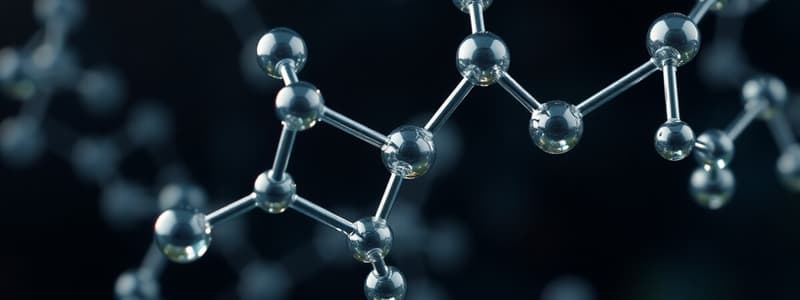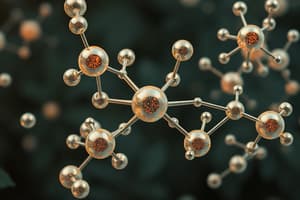Podcast
Questions and Answers
What are organic compounds?
What are organic compounds?
Organic compounds are chemical substances that make up organisms and help organisms carry out life processes.
Without carbon, life as we know it would continue to exist.
Without carbon, life as we know it would continue to exist.
False (B)
Which of the following are examples of carbon compounds found in organisms?
Which of the following are examples of carbon compounds found in organisms?
- Lipids (correct)
- Proteins (correct)
- Carbohydrates (correct)
- Nucleic acids (correct)
What is the primary function of carbohydrates?
What is the primary function of carbohydrates?
Which of the following is a monosaccharide often found in fruits?
Which of the following is a monosaccharide often found in fruits?
What is the main form of stored energy in animals?
What is the main form of stored energy in animals?
Lipids are soluble in water.
Lipids are soluble in water.
What are the two main categories of fatty acids?
What are the two main categories of fatty acids?
What type of fatty acids are typically found in plants?
What type of fatty acids are typically found in plants?
What are the building blocks of proteins?
What are the building blocks of proteins?
Proteins can bond with other molecules very specifically and tightly.
Proteins can bond with other molecules very specifically and tightly.
What is the process of protein denaturation?
What is the process of protein denaturation?
What are the building blocks of nucleic acids?
What are the building blocks of nucleic acids?
What are the four bases found in DNA?
What are the four bases found in DNA?
What is the role of RNA?
What is the role of RNA?
Flashcards
Carbon
Carbon
A chemical compound that is the fundamental building block of life, known for its ability to form four bonds and create complex molecules.
Organic Compounds
Organic Compounds
A chemical substance that is essential for life. These compounds are composed of carbon and hydrogen, and often include oxygen, nitrogen, sulfur and phosphorus.
Carbohydrates
Carbohydrates
One or more simple sugar units (monosaccharides) linked together. They provide energy for living cells, store energy, and form structural tissues.
Monosaccharide
Monosaccharide
Signup and view all the flashcards
Disaccharide
Disaccharide
Signup and view all the flashcards
Polysaccharide
Polysaccharide
Signup and view all the flashcards
Lipids
Lipids
Signup and view all the flashcards
Fatty Acid
Fatty Acid
Signup and view all the flashcards
Phospholipid
Phospholipid
Signup and view all the flashcards
Steroid
Steroid
Signup and view all the flashcards
Saturated Fatty Acid
Saturated Fatty Acid
Signup and view all the flashcards
Unsaturated Fatty Acid
Unsaturated Fatty Acid
Signup and view all the flashcards
Triglyceride
Triglyceride
Signup and view all the flashcards
Proteins
Proteins
Signup and view all the flashcards
Amino Acid
Amino Acid
Signup and view all the flashcards
Peptide
Peptide
Signup and view all the flashcards
Polypeptide
Polypeptide
Signup and view all the flashcards
Protein Denaturation
Protein Denaturation
Signup and view all the flashcards
Nucleic Acids
Nucleic Acids
Signup and view all the flashcards
Nucleotide
Nucleotide
Signup and view all the flashcards
DNA
DNA
Signup and view all the flashcards
RNA
RNA
Signup and view all the flashcards
Genetic Code
Genetic Code
Signup and view all the flashcards
Protein Synthesis
Protein Synthesis
Signup and view all the flashcards
Transcription
Transcription
Signup and view all the flashcards
Translation
Translation
Signup and view all the flashcards
Study Notes
The Chemistry of Life: Organic Compounds
- Organic compounds are chemical substances making up organisms and aiding life processes.
- All organic compounds contain carbon and hydrogen.
- Carbon is the central element in organic molecules; without it, life as we know it would cease to exist.
Lesson Objectives
- Carbon's essential role in life on Earth is explained.
- Structures and functions of carbohydrates, lipids, proteins, and nucleic acids are described.
Introduction
- Organic compounds form the basis of life.
- They are involved in all life processes.
The Significance of Carbon
- Nearly 10 million carbon-containing organic compounds are known.
- Carbon compounds in organisms include carbohydrates, lipids, proteins, and nucleic acids.
- Carbon bonds with various elements, forming large, complex molecules.
- Bonds include single, double, and triple bonds with other carbon atoms and other elements.
Carbohydrates
- Carbohydrates contain carbon, hydrogen, and oxygen.
- They are the most common type of organic compound.
- They are made of one or more monosaccharides (simple sugars).
- Simple carbohydrates are found in fruits, milk, and vegetables; examples include cake, candy, and refined sugars.
- Simple carbohydrates provide energy, but often lack vitamins, minerals, and fiber.
- Complex carbohydrates are found in breads, legumes, rice, pasta, and starchy vegetables.
- They provide vitamins, minerals, and fiber in addition to energy.
Monosaccharides and Disaccharides
- Common monosaccharides include glucose and fructose
- Two monosaccharides bonded together form a disaccharide, e.g., sucrose (table sugar)
- Monosaccharides and disaccharides are known as simple sugars.
- They provide energy to living cells.
Polysaccharides
- Two or more monosaccharides form a polysaccharide.
- Polysaccharides may contain several thousand monosaccharides.
- Main functions are energy storage and structural tissues (cell walls, exoskeletons).
The Compounds of Life
| Type of Compound | Composition (Elements) | Function | Examples | Monomer |
|---|---|---|---|---|
| Carbohydrates | Carbon, Hydrogen, Oxygen (C,H,O) | Provide energy to living cells; form structural tissue | Glucose, Fructose, Sucrose, Glycogen, Cellulose | Monosaccharides |
| Lipids | Carbon, Hydrogen, Oxygen (C,H,O) | Hydrophobic; form cell membranes; store energy | Fats, Oils, Waxes, Steroids | Glycerol & 3 Fatty Acids |
| Proteins | Carbon, Hydrogen, Oxygen, Nitrogen (C,H,O,N) | Maintain cell shape; make muscle tissue; speed up chemical reactions; carry messages | Enzymes, Antibodies | Amino Acids |
| Nucleic Acids | Carbon, Hydrogen, Oxygen, Nitrogen, Phosphorus (C,H,O,N,P) | Pass on traits; code for amino acids | Deoxyribonucleic acid (DNA), Ribonucleic acid (RNA) | Nucleotides |
Lipids
- Lipids contain carbon, hydrogen, and oxygen.
- Lipids include fats, oils, and waxes.
- Lipid molecules consist of glycerol and three fatty acids.
- Lipids are hydrophobic (non-polar).
- Several types of lipids can consist of additional molecules.
- Triglycerides are the main form of stored energy in animals.
- Phospholipids are major components of cell membranes.
- Steroids have a variety of functions, including components of cell membranes (cholesterol) and hormones (male and female sex hormones).
Saturated Fatty Acids
- Saturated fatty acids are solids at room temperature.
- Hydrogen atoms surround each carbon atom.
- They form straight chains packed tightly.
Unsaturated Fatty Acids
- Unsaturated fatty acids are liquids at room temperature.
- Some carbon atoms are bonded to fewer hydrogen atoms.
- They form bent chains, not packed tightly.
Lipids and Diet
- Humans need lipids for energy and forming cell membranes.
- Essential fatty acids (omega-3s and omega-6s) must be obtained from food.
- Excess dietary lipids can be harmful, leading to weight gain and cardiovascular disease.
Proteins
- Proteins contain carbon, hydrogen, oxygen, and nitrogen.
- Proteins are made of smaller units called amino acids.
- 20 different common amino acids compose proteins.
- Proteins can have just a few or several hundred amino acids.
- Proteins play many essential roles in organisms — providing structure, speeding up chemical reactions, transporting materials, and defending against disease.
- Proteins bond with other molecules tightly.
Amino Acid Structure
- Amino acids share a basic structure.
- They have a 'R' group, an amino group (NH2), and a carboxyl group (COOH).
Protein Structure
- Amino acids bond together to form peptides and polypeptides.
- Proteins can be composed of one or more polypeptide chains.
Proteins and Diet
- Dietary proteins break down into amino acids for use in building new proteins.
- Humans can synthesize most amino acids, but eight are essential and must come from food.
Protein Denaturation
- Protein denaturation is a change in protein shape, disrupting function.
- Denaturation can be caused by extreme conditions such as heat, acidity, or force.
Nucleic Acids
- Nucleic acids contain carbon, hydrogen, oxygen, nitrogen, and phosphorus.
- Nucleic acids are made of smaller units called nucleotides.
- Nucleic acids are found in all living cells and viruses.
- Types of nucleic acids include DNA and RNA.
Structure of Nucleic Acids
- Nucleic acids consist of one or two chains of nucleotides.
- Each nucleotide has a base, a sugar, and a phosphate group.
- DNA bases: Adenine, Guanine, Cytosine, Thymine
- RNA bases: Adenine, Guanine, Cytosine, Uracil
- The sugar in DNA is deoxyribose; in RNA, it is ribose.
Role of Nucleic Acids
- The order of bases in nucleic acids is significant.
- Base sequences form genetic codes that determine protein structures.
- Information is passed along during cell division and reproduction.
How RNA Codes for Proteins
- DNA provides the genetic blueprint for protein assembly.
- RNA uses DNA information to assemble amino acids into proteins.
Studying That Suits You
Use AI to generate personalized quizzes and flashcards to suit your learning preferences.




